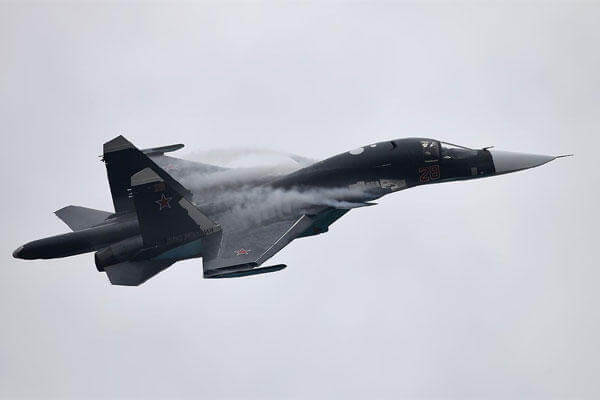For the second day, Russian warplanes used an airbase in Iran to hit targets in Syria Wednesday in another sign of growing cooperation between Moscow and Tehran to counter U.S. interests in the region.
Russia's Defense Ministry also mockingly dismissed U.S. State Department charges that the arrangement for use of the Iranian airbase southwest of Tehran could be in violation of the United Nations Security Council resolution 2231 prohibiting the supply, sale and transfer of combat aircraft to Iran.
The second consecutive day of bombing missions from Iran's Hamadan airbase about 175 miles southwest of Tehran involved Sukhoi Su-34 strike aircraft, called Fullbacks by NATO, according to the Russian news outlet RT.
Once they reached Syrian airspace, the Su-34 aircraft were escorted by Su-35 fighters, known as Flanker-Es, flying out of the Syria's Khmeimim airbase near the port city of Latakia, RT said, citing the Russian Defense Ministry. The Fullbacks reportedly hit Islamic State of Iraq and Syria, or ISIS, targets near the eastern Syrian city of Deir al-Zour.
"Over 150 militants have been eliminated, among them foreign mercenaries," in the strikes, the Defense Ministry said in a statement.
On Tuesday, Russian bombers used the Iranian airbase for the first time. The strike wave consisted of Su-34s and long-range Tu-22M3 bombers, called Backfires by NATO, against targets in Deir al-Zour Aleppo and Idlib, Army Col. Chris Carver, a spokesman for Combined Joint Task Force-Operation Inherent Resolve, said in a video briefing to the Pentagon on Tuesday.
For those strikes, "the Russians did notify the coalition" under the memorandum of understanding on flight safety over Syria that was agreed to by the two countries, Garver said. "They informed us they were coming through. We assured safety of flight as those bombers passed through the area and toward their target and then when they passed out again," he said.
It was not immediately clear whether the Russians gave notice for the strikes on Wednesday.
Secretary of State John Kerry phoned his Russian counterpart, Foreign Minister Sergei Lavrov, after the first strikes Tuesday to express U.S. concerns and also to try again to get Russia to use its influence with Syrian President Bashar al-Assad to arrange a ceasefire that would ease the siege of Aleppo.
"Discussion of the situation in Syria continued with a focus on the situation in Aleppo, where government forces are conducting a large-scale humanitarian operation with Russian support," the Russian Foreign Ministry said in a statement on the Kerry-Lavrov phone call.
Also on Tuesday, State Department Spokesman Mark Toner said the Russian airstrikes out of Iran had killed civilians and suggested that they might constitute a violation of the UN resolution on military cooperation with Iran.
Maj. Gen. Igor Konashenkov, a spokesman for Russia's Ministry of Defense, responded Wednesday in a mocking statement singling out Toner by name.
"It is against our rules to provide advice to the leadership of the U.S. State Department, but it's hard to resist a recommendation for some State Department representatives to check their logic and knowledge of fundamental documents of international law," Konashenkov said.
In the regular State Department briefing Wednesday, Toner said that the Russian airstrikes out of Iran "continue to hit civilian populations. Our concerns remain very vivid." Kerry's phone call to Lavrov was focused on trying to arrange a ceasefire "and this doesn't help," Toner said. "It only exacerbates what is already a dangerous situation."
When asked whether Russia was in violation of the UN resolution, Toner said, "Our lawyers are looking at it. It requires a very detailed legal analysis."
-- Richard Sisk can be reached at Richard.Sisk@Military.com.




























